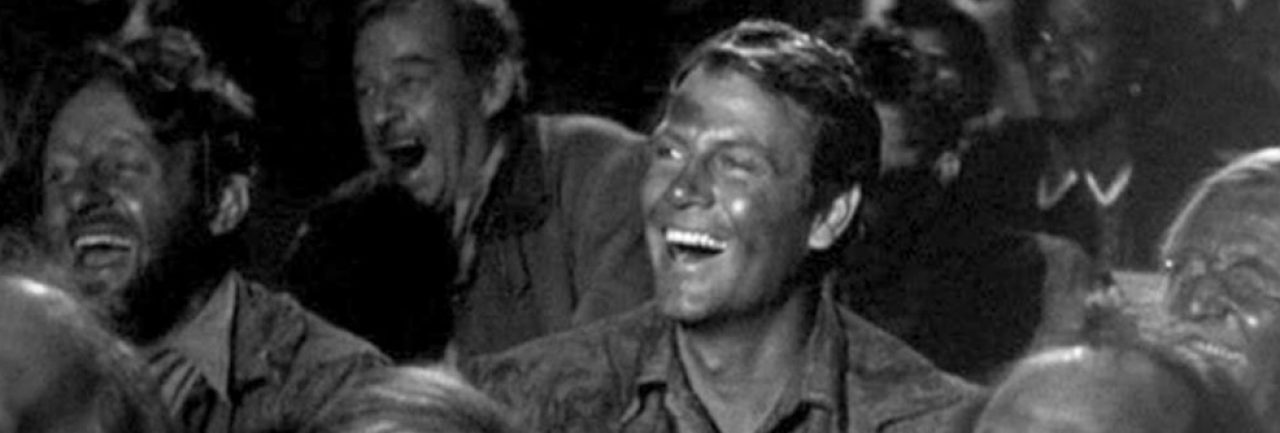
I was looking around on the invaluable Films in Films site and came on an entry for Roy Del Ruth’s 1932 movie Taxi. (Films in Films lists it as Taxi! but the original posters and such do not have an exclamation mark.) FIF says the film includes scenes from the same director’s Side Show, released the previous year. This was exciting to me because, up till now, the earliest example I’ve found of a sound film using clips from another sound film is Wild Boys of the Road (1933), which uses Footlight Parade. And Taxi came out more than a year earlier.
The movie-in-movie situation turned out to be a bit more complicated than that, which I’ll get to in a minute. But to start, Taxi (available for rental on Amazon Prime) is a weird, wonderful, and disturbing movie. The bread and butter of impressionists used to be James Cagney saying, “You dirty rat. You killed my brother.” And that started with Taxi, where Cagney plays New York City cabdriver Matt Nolan. As with many famous lines, he didn’t say exactly those words. A bad guy does indeed kill his brother, and in one improbable plot turn, Matt’s wife, Sue (Loretta Young), gives some assistance to the killer. Matt shoves Sue around (he’s always socking people, dames included) and says, “The dirty rat kills Danny and you help him get away with it!” Later, a la R. Kelly, the killer is locked in a closet and Matt exclaims, “Come out and take it, you dirty yellow-bellied rat or I’ll give it to ya through the door!” Spoiler alert: he goes ahead and shoots. Matt’s a true sociopath, and the disturbing thing is the movie pretty much gives him a pass on that.
Taxi also has this kind of amazing scene:
Cagney was born on the Lower East Side and really did speak Yiddish. An article in the Forward summarizes what’s going on here:
The man tells the policeman that he urgently needs to go to Ellis Island because his wife and children are due to arrive and becomes incensed that the cop cannot understand his “plain Mame-Loshn.” After insulting the cop, calling him fat and a dummy — literally: a “gentile head” — the Jewish man asks Matt if he is a fellow member of the tribe. “What else would I be, a sheygets?,” Cagney’s character responds. (Sheygets is the male equivalent of a shiksa.)
And one more little sidelight. In another amazing scene, Sue and Matt enter a foxtrot contest, and who should beat them out but an uncredited George Raft, in one of his first roles?
I came to Taxi after watching Footlight Parade and a bunch of other Warner Brothers pre-Code musicals, and it’s fun to watch members of the Warners stock company like Guy Kibbee and George E. Stone show up in non-musical roles. In this sequence, Matt and Sue go to the movies with Stone (as fellow cabbie Skeets) and Leila Bennett, playing a wise-cracking waitress, Ruby (and stealing the picture).
Gentle fun is poked at Warners star John Barrymore, and slightly less gentle at Paramount’s Fredric March, who had just played a Barrymore-like thespian in The Royal Family of Broadway. Ruby’s favorite, Joe E. Brown, was a comedy star at Warners.
Here’s the movie-in-movie:
In the entire history of movie-in-movies scenes, from silent days up through Mad Men, the predominant theme for the trope has been a contrast between the idealized or hokey, “Hollywood” world that the characters watch, and their own “real” world. (And the enduring richness of the trope, of course, derives from the fact that their world isn’t really real, either.) Here, what’s onscreen is hokey and Hollywood to the max: with stilted acting, lousy synchronization, and melodramatic lines like, “My life seems misspent. The meaning has gone out of everything and left only … ashes.” (The dialogue brings to mind the scene in Harold Pinter’s The Last Tycoon script where Robert DeNiro, playing an Irving Thalberg-like executive, rips a screenwriter for the line he’s penned in response to “I love you” — “And I you!”)
The Taxi characters’ reaction eliminates any doubt we might have about the badness of the movie they and we are watching. And by the way, Cagney’s line in reference to the male lead, Donald Cook –“His ears are too big” — is another in-joke. That was commonly said about another actor from a rival studio, MGM’s Clark Gable.
Now as to the identity of that crummy movie. The marquee says it’s Her Hour of Love — “GREATEST PICTURE OF ALL TIME.” (Hardy har har.) There is no such film, though One Hour of Love was a 1927 silent. Both Films in Films and IMDB say the actual footage is from Side Show, directed by Del Ruth in 1931. That is not true, as I can attest now that I’ve seen Side Show, which is available for rental on YouTube. That film does indeed feature Cook and Evalyn Knapp (the onscreen lovers) but it’s a circus-set comic adventure. Del Ruth, Cook, and Knapp worked up this scene especially for Taxi.
So Wild Boys of the Road still hasn’t been displaced. Taxi does, however, hold the distinction of being the first movie to include clips from a fake movie, and that is not nothing.

Very cool! I had seen that amazing clip of Cagney speaking Yiddish before but hadn’t known what movie it came from. BTW, even though IMDb’s “movie connections” page inaccurately suggests the footage is from Side Show, the trivia page gives the correct information: “The movie-within-a-movie, Her Hour of Love, with Donald Cook and Evalyn Knapp, was not an actual film clip, but a new sequence especially filmed for Taxi.”
LikeLike
Yes, I did see the spot-on trivia comment.
LikeLike